The Role of Digital Agriculture in Mitigating Climate Change and Ensuring Food Security: An Overview
Abstract
1. Introduction
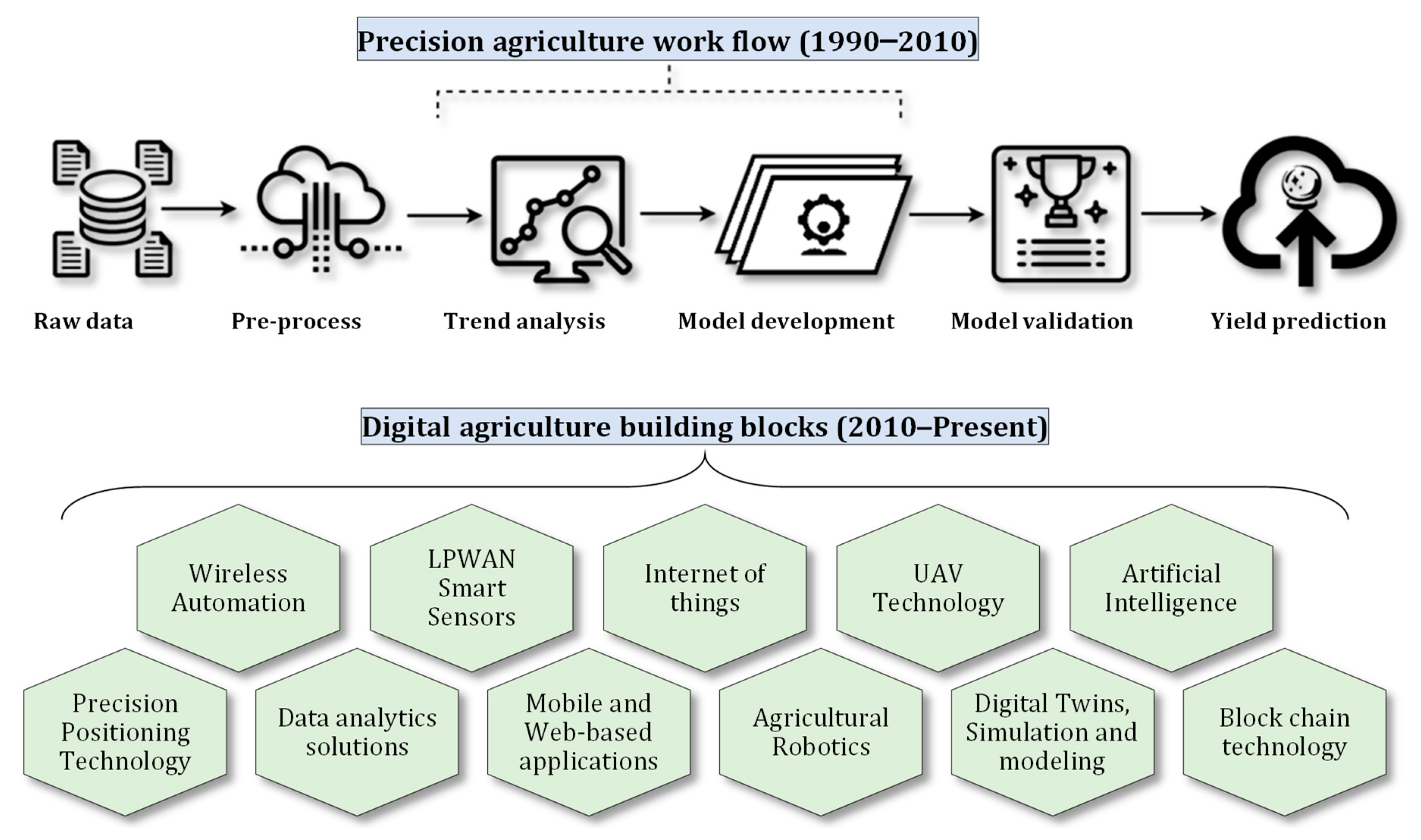
2. Impact of Climate Change on Agriculture
2.1. Impact on Crop Production
2.2. Impact on Soil
3. Impact of Climate Change on Livestock and Fisheries
4. Building Climate Resilience from Precision and Digital Agriculture Strategies
4.1. Precision Nutrient Management
4.2. Precision Water Management
4.3. Precision Land Use Management
5. Digital Agriculture Adoption
6. Framework for Climate-Smart Agriculture
6.1. Crop Management
6.2. Livestock Management
6.3. Soil, Water and Nutrient Management
6.4. Carbon and Energy Management
7. Conclusions
Author Contributions
Funding
Institutional Review Board Statement
Informed Consent Statement
Data Availability Statement
Acknowledgments
Conflicts of Interest
References
- Basso, B.; Antle, J. Digital agriculture to design sustainable agricultural systems. Nat. Sustain. 2020, 3, 254–256. [Google Scholar] [CrossRef]
- Sparrow, R.; Howard, M. Robots in agriculture: Prospects, impacts, ethics, and policy. Precis. Agric. 2021, 22, 818–833. [Google Scholar] [CrossRef]
- Shamshiri, R.; Weltzien, C.; Hameed, I.A.; Yule, I.; Grift, T.; Balasundram, S.K.; Pitonakova, L.; Ahmad, D.; Chowdhary, G. Research and development in agricultural robotics: A perspective of digital farming. Int. J. Agric. Biol. Eng. 2018, 11, 4. [Google Scholar] [CrossRef]
- Dlodlo, N.; Kalezhi, J. The internet of things in agriculture for sustainable rural development. In Proceedings of the 2015 International Conference on Emerging Trends in Networks and Computer Communications (ETNCC), Windhoek, Namibia, 17–20 May 2015; IEEE: Piscataway, NJ, USA, 2015; pp. 13–18. [Google Scholar]
- Smith, P.; Soussana, J.F.; Angers, D.; Schipper, L.; Chenu, C.; Rasse, D.P.; Batjes, N.H.; Van Egmond, F.; McNeill, S.; Kuhnert, M.; et al. How to measure, report and verify soil carbon change to realize the potential of soil carbon sequestration for atmospheric greenhouse gas removal. Glob. Chang. Biol. 2020, 26, 219–241. [Google Scholar] [CrossRef] [PubMed]
- Mahato, A. Climate change and its impact on agriculture. Int. J. Sci. Res. Publ. 2014, 4, 1–6. [Google Scholar]
- Lindsey, R. Climate Change: Atmospheric Carbon Dioxide. 2020. Available online: https://www.climate.gov/author/rebecca-lindsey (accessed on 23 December 2022).
- Gaffney, O.; Steffen, W. The anthropocene equation. Anthr. Rev. 2017, 4, 53–61. [Google Scholar] [CrossRef]
- Tabari, H. Climate change impact on flood and extreme precipitation increases with water availability. Sci. Rep. 2020, 10, 1–10. [Google Scholar] [CrossRef]
- Dupar, M. IPCC’s Special Report on Climate Change and Land: What’s in It for South Asia? Overseas Development Institute, ICLEI-South Asia and South, North; Climate and Development Knowledge Network: Cape Town, South Africa, 2019. [Google Scholar]
- Do Prado Tanure, T.M.; Miyajima, D.N.; Magalhães, A.S.; Domingues, E.P.; Carvalho, T.S. The impacts of climate change on agricultural production, land Use and economy of the legal Amazon region between 2030 and 2049. Economia 2020, 21, 73–90. [Google Scholar] [CrossRef]
- Patterson, L.A.; Lutz, B.; Doyle, M.W. Climate and direct human contributions to changes in mean annual streamflow in the South Atlantic, USA. Water Resour. Res. 2013, 49, 7278–7291. [Google Scholar] [CrossRef]
- IPCC (Intergovernmental Panel on Climate Change). Working Group 1, Fifth Assessment Report on Climate Change 2013: The Physical Science Basis; Intergovernmental Panel on Climate Change: Geneva, Switzerland, 2013. [Google Scholar]
- Dubey, R.K.; Tripathi, V.; Dubey, P.K.; Singh, H.B.; Abhilash, P.C. Exploring rhizospheric interactions for agricultural sustainability: The need of integrative research on multi-trophic interactions. J. Clean. Prod. 2016, 115, 362–365. [Google Scholar] [CrossRef]
- FAO (Food and Agriculture Organization). The State of Food and Agriculture: Climate Change, Agriculture and Food Security; FAO: Rome, Italy, 2016; pp. 1–173. [Google Scholar]
- Janina. What Does Warsaw Mean for Agriculture? Food (Policy) for Thought, 25 November 2013; pp. 1–7. [Google Scholar]
- Wijerathna-Yapa, A.; Pathirana, R. Sustainable Agro-Food Systems for Addressing Climate Change and Food Security. Agriculture 2022, 12, 1554. [Google Scholar] [CrossRef]
- Karmakar, R.; Das, I.; Dutta, D.; Rakshit, A. Potential effects of climate change on soil properties: A review. Sci. Int. 2016, 4, 51–73. [Google Scholar] [CrossRef]
- Lal, R.; Delgado, J.A.; Groffman, P.M.; Millar, N.; Dell, C.; Rotz, A. Management to mitigate and adapt to climate change. J. Soil Water Conserv. 2011, 66, 276–285. [Google Scholar] [CrossRef]
- Pareek, N. Climate change impact on soils: Adaptation and mitigation. MOJ Ecol. Environ. Sci. 2017, 2, 136–139. [Google Scholar] [CrossRef]
- Corwin, D.L. Climate change impacts on soil salinity in agricultural areas. Eur. J. Soil Sci. 2021, 72, 842–862. [Google Scholar] [CrossRef]
- Hailu, B.; Mehari, H. Impacts of soil salinity/sodicity on soil-water relations and plant growth in dry land areas: A review. J. Nat. Sci. Res. 2021, 12, 1–10. [Google Scholar]
- Mayowa, O.O.; Pour, S.H.; Shahid, S.; Mohsenipour, M.; Harun, S.B.; Heryansyah, A.; Ismail, T. Trends in rainfall and rainfall-related extremes in the east coast of peninsular Malaysia. J. Earth Syst. Sci. 2015, 124, 1609–1622. [Google Scholar] [CrossRef]
- Corwin, D.L.; Bradford, S.A. Environmental impacts and sustainability of degraded water reuse. J. Environ. Qual. 2008, 37 (Suppl. S5), S1. [Google Scholar] [CrossRef]
- Rojas-Downing, M.M.; Nejadhashemi, A.P.; Harrigan, T.; Woznicki, S.A. Climate change and livestock: Impacts, adaptation, and mitigation. Clim. Risk Manag. 2017, 16, 145–163. [Google Scholar] [CrossRef]
- Garnett, T. Livestock-related greenhouse gas emissions: Impacts and options for policy makers. Environ. Sci. Policy 2009, 12, 491–503. [Google Scholar] [CrossRef]
- Sejian, V. Climate change: Impact on production and reproduction, adaptation mechanisms and mitigation strategies in small ruminants: A review. Indian J. Small Rumin. 2013, 19, 1–21. [Google Scholar]
- Koirala, A.; Bhandari, P. Impact of Climate Change on Livestock Production. NVJ 2019, 36, 178–183. [Google Scholar] [CrossRef]
- Henry, B.; Charmley, E.; Eckard, R.; Gaughan, J.B.; Hegarty, R. Livestock production in a changing climate: Adaptation and mitigation research in Australia. Crop Pasture Sci. 2012, 63, 191–202. [Google Scholar] [CrossRef]
- Chapman, S.C.; Chakraborty, S.; Dreccer, M.F.; Howden, S.M. Plant adaptation to climate change opportunities and priorities in breeding. Crop Pasture Sci. 2012, 63, 251–268. [Google Scholar] [CrossRef]
- Nardone, A.; Ronchi, B.; Lacetera, N.; Ranieri, M.S.; Bernabucci, U. Effects of climate changes on animal production and sustainability of livestock systems. Livest. Sci. 2010, 130, 57–69. [Google Scholar] [CrossRef]
- Polley, H.W.; Briske, D.D.; Morgan, J.A.; Wolter, K.; Bailey, D.W.; Brown, J.R. Climate change and North American rangelands: Trends, projections, and implications. Rangel. Ecol. Manag. 2013, 66, 493–511. [Google Scholar] [CrossRef]
- Johnson, R.K.; Johnson, D.E. Impacts of global warming on animal production and health. J. Anim. Sci. 2017, 95, 2497–2507. [Google Scholar]
- Gerber, P.J.; Steinfeld, H.; Henderson, B.; Mottet, A.; Opio, C.; Dijkman, J.; Tempio, G. Tackling Climate Change through Livestock: A Global Assessment of Emissions and Mitigation Opportunities; Food and Agriculture Organization of the United Nations (FAO): Rome, Italy, 2013. [Google Scholar]
- Saleh, R.; Miller, R. Effects of Climate change on livestock health and production. J. Anim. Sci. 2011, 89, 2100–2111. [Google Scholar]
- Takahashi, K.; Kimura, A.; Shirai, T. Impacts of climate change on livestock and poultry production in Asia. Asian-australas. J. Anim. Sci. 2017, 30, 1211–1220. [Google Scholar]
- Cheung, W.W.; Lam, V.W.; Sarmiento, J.L.; Kearney, K.; Watson, R.E.G.; Zeller, D.; Pauly, D. Large-scale redistribution of maximum fisheries catch potential in the global ocean under climate change. Glob. Chang. Biol. 2010, 16, 24–35. [Google Scholar] [CrossRef]
- FAO (Food and Agriculture Organization). In Brief, The State of World Fisheries and Aquaculture; FAO: Rome, Italy, 2018. [Google Scholar]
- Yasmin, R.; Islam, M. Sustainability of fisheries and aquaculture in context of emerging climate change issues. Int. J. Fish. Aquat. 2017, 5, 176–187. [Google Scholar]
- Cheung, W.W.L.; Lam, V.W.Y.; Sarmiento, J.L.; Kearney, K.; Watson, R.; Pauly, D. Projecting global marine biodiversity impacts under climate change scenarios. Fish Fish. 2009, 10, 235–251. [Google Scholar] [CrossRef]
- Harle, J.; Dunn, D.C.; Pearman, P.J. Impacts of climate change on global marine biodiversity. Biodivers. Conserv. 2014, 23, 2773–2795. [Google Scholar]
- Vallero, D.A. Air Pollution Biogeochemistry. In Air Pollution Calculations; Elsevier: Amsterdam, The Netherlands, 2019; pp. 175–206. [Google Scholar] [CrossRef]
- Hassan, M.U.; Aamer, M.; Mahmood, A.; Awan, M.I.; Barbanti, L.; Seleiman, M.F.; Bakhsh, G.; Alkharabsheh, H.M.; Babur, E.; Shao, J.; et al. Management strategies to mitigate N2O emissions in agriculture. Life 2022, 12, 439. [Google Scholar] [CrossRef]
- Panhwar, Q.A.; Ali, A.; Naher, U.A.; Memon, M.Y. Fertilizer management strategies for enhancing nutrient use efficiency and sustainable wheat production. In Organic Farming; Woodhead Publishing: Sawston, UK, 2019; pp. 17–39. [Google Scholar]
- Sridhara, S. Decision support systems and crop simulation models for effective nutrient management. In Training Manual on Soil Health Management Techniques in Rice and Rice Based Cropping Systems; Ranga Agricultural University: Guntur, India, 2014; pp. 169–173. [Google Scholar]
- Raja, D.; Balachandra, Y. Decision Support Systems and Crop Simulation Models for Effective Nutrient Management. In Research Trends in Agriculture Sciences; Naresh, R.K., Ed.; AkiNik Publications: New Delhi, India, 2021; Volume 10, pp. 135–142. [Google Scholar]
- Chivenge, P.; Zingore, S.; Ezui, K.S.; Njoroge, S.; Bunquin, M.A.; Dobermann, A.; Saito, K. Progress in research on site-specific nutrient management for smallholder farmers in sub-Saharan Africa. Field Crops Res. 2022, 281, 108503. [Google Scholar] [CrossRef]
- Pampolino, M.F.; Witt, C.; Pasuquin, J.M.; Johnston, A.M.; Fisher, M.J. Development and evaluation of Nutrient Expert® decision support tool for cereal crops. Better Crops-South Asia 2014, 8, 4–6. [Google Scholar]
- Sharma, L.K.; Bali, S.K. A review of methods to improve nitrogen use efficiency in agriculture. Sustainability 2018, 10, 51. [Google Scholar] [CrossRef]
- Dutta, S.K.; Majumdar, K.; Satyanarayana, T. India: Nutrient Expert: A precision nutrient management tool for smallholder production systems of India. J. Soils Crop 2014, 47, 23–25. [Google Scholar] [CrossRef]
- Setiyono, T.D.; Walters, D.T.; Cassman, K.G.; Witt, C.; Dobermann, A. Estimating maize nutrient uptake requirements. Field Crops Res. 2010, 118, 158–168. [Google Scholar] [CrossRef]
- Takebe, M.; Yoneyama, T. Measurement of leaf color scores and its implication to nitrogen nutrition of rice plants. Jpn. Agric. Res. Q. 1989, 23, 86–93. [Google Scholar]
- Witt, C.; Pasuquin, J.M.C.A.; Mutters, R.; Buresh, R.J. New leaf color chart for effective nitrogen management in rice. Better Crops 2005, 89, 36–39. [Google Scholar]
- Colaço, A.F.; Molin, J.P. Variable rate fertilization in citrus: A long term study. Precis. Agric. 2017, 18, 169–191. [Google Scholar] [CrossRef]
- Chivenge, P.; Sharma, S.; Bunquin, M.A.; Hellin, J. Improving nitrogen use efficiency—A key for sustainable rice production systems. Front. Sustain. Food Syst. 2021, 400, 737412. [Google Scholar] [CrossRef]
- Sapkota, T.B.; Jat, M.L.; Rana, D.S.; Khatri-Chhetri, A.; Jat, H.S.; Bijarniya, D.; Majumdar, K. Crop nutrient management using Nutrient Expert improves yield, increases farmers’ income and reduces greenhouse gas emissions. Sci. Rep. 2021, 11, 1–11. [Google Scholar] [CrossRef] [PubMed]
- Bhatia, A.; Pathak, H.; Jain, N.; Singh, P.K.; Tomer, R. Greenhouse gas mitigation in rice–wheat system with leaf color chart-based urea application. Environ. Monit. Assess. 2012, 184, 3095–3107. [Google Scholar] [CrossRef]
- Koch, B.; Khosla, R.; Frasier, W.M.; Westfall, D.G.; Inman, D. Economic feasibility of variable-rate nitrogen application utilizing site-specific management zones. J. Agron. 2004, 96, 1572–1580. [Google Scholar] [CrossRef]
- Pathak, H.; Bhatia, A.; Jain, N. Greenhouse Gas Emission from Indian Agriculture: Trends, Mitigation and Policy Needs; Indian Agricultural Research Institute: New Delhi, India, 2014; Volume 39. [Google Scholar]
- Gosal, S.K.; Choudhary, R.; Singh, R.; Adholeya, A. Improving nitrogen use efficiency using precision nitrogen management in wheat (Triticum aestivum L.). J. Plant Nutr. Soil Sci. 2021, 184, 371–377. [Google Scholar]
- Hedley, C. The role of precision agriculture for improved nutrient management on farms. J. Sci. Food Agric. 2015, 95, 12–19. [Google Scholar] [CrossRef]
- Goff, L.P. Precision Agriculture’s Impact on Nutrient Management in Agronomic Crops. Master’s Thesis, Virginia Polytechnic Institute and State University, Blacksburg, VA, USA, 2019. [Google Scholar]
- Brar, B.S.; Kaur, A. Precision Nutrient Management: A Review. Indian J. Fertil. 2016, 1, 15. [Google Scholar]
- Robert, P.C. Precision agriculture: A challenge for crop nutrition management. In Progress in Plant Nutrition: Plenary Lectures of the XIV International Plant Nutrition Colloquium: Food Security and Sustainability of Agro-Ecosystems through Basic and Applied Research; Springer: Dordrecht, The Netherlands, 2002; pp. 143–149. [Google Scholar]
- Barman, A.; Hoque, A.; Bera, A.; Saha, P. Chapter Precision Nutrient Management as a Climate Smart Strategy under Conservation Agriculture-Based Cropping System; Bhumi Publishing: Kolhapur, India, 2022; pp. 1–36. [Google Scholar]
- Adeyemi, O.; Grove, I.; Peets, S.; Norton, T. Advanced monitoring and management systems for improving sustainability in precision irrigation. Sustainability 2017, 9, 353. [Google Scholar] [CrossRef]
- FAOSTAT. FAOSTAT Data. Statistics Division (FAOSTAT), Food and Agriculture Organization of the United Nations, Rome, Italy. 2015. Available online: http://www.fao.org/faostat/en/#data (accessed on 25 December 2022).
- Pathak, H.; Bhatia, A.; Jain, N.; Aggarwal, P.K. Greenhouse gas emission and mitigation in Indian agriculture–A review. ING Bull. Reg. Assess. React. Nitrogen Bull. 2010, 19, 1–34. [Google Scholar]
- Parthasarathi, T.; Vanitha, K.; Mohandass, S.; Vered, E. Mitigation of methane gas emission in rice by drip irrigation. F1000Research 2019, 8, 2023. [Google Scholar] [CrossRef] [PubMed]
- Islam, S.M.; Gaihre, Y.K.; Islam, M.R.; Akter, M.; Al Mahmud, A.; Singh, U.; Sander, B.O. Effects of water management on greenhouse gas emissions from farmers’ rice fields in Bangladesh. Sci. Total Environ. 2020, 734, 139382. [Google Scholar] [CrossRef] [PubMed]
- Hiya, H.J.; Ali, M.A.; Baten, M.A.; Barman, S.C. Effect of Water Saving Irrigation Management Practices on Rice Productivity and Methane Emission from Paddy Field. J. Geosci. Environ. Prot. 2020, 8, 182–196. [Google Scholar] [CrossRef]
- Win, E.P.; Win, K.K.; Bellingrath-Kimura, S.D.; Oo, A.Z. Greenhouse gas emissions, grain yield and water productivity: A paddy rice field case study based in Myanmar. Greenh. Gases Sci. Technol. 2020, 10, 884–897. [Google Scholar] [CrossRef]
- Sikka, A.K.; Alam, M.F.; Mandave, V. Agricultural water management practices to improve the climate resilience of irrigated agriculture in India. Irrig. Drain. 2022, 71, 7–26. [Google Scholar] [CrossRef]
- Neupane, J.; Guo, W. Agronomic basis and strategies for precision water management: A review. Agronomy 2019, 9, 87. [Google Scholar] [CrossRef]
- Srinivasan, A. Precision water management: Current realities, possibilities, and trends. In Handbook of Precision Agriculture; CRC Press: Boca Raton, FL, USA, 2006; pp. 183–214. [Google Scholar]
- Den Besten, N.; Steele-Dunne, S.; de Jeu, R.; van der Zaag, P. Towards monitoring waterlogging with remote sensing for sustainable irrigated agriculture. Remote Sens. 2021, 13, 2929. [Google Scholar] [CrossRef]
- Brahmanand, P.S.; Singh, A.K. Precision Irrigation Water Management-Current Status, Scope and Challenges. Indian J. Fertil. 2022, 18, 372–380. [Google Scholar]
- Everest, T.; Koparan, H.; Sungur, A.; Özcan, H. An important tool against combat climate change: Land suitability assessment for canola (a case study: Çanakkale, NW Turkey). Environ. Dev. Sustain. 2021, 24, 1–36. [Google Scholar] [CrossRef]
- Fisher, B.; Nakicenovic, N.; Alfsen, K.; Corfee-Morlot, J.; Riahi, K. Issues Related to Mitigation in the Long-Term Context (Chapter 3); Cambridge University Press: Cambridge, UK, 2007. [Google Scholar]
- Vasu, D.; Srivastava, R.; Patil, N.G.; Tiwary, P.; Chandran, P.; Singh, S.K. A comparative assessment of land suitability evaluation methods for agricultural land use planning at village level. Land Use Policy 2018, 79, 146–163. [Google Scholar] [CrossRef]
- Ghosh, P.; Kumpatla, S.P. GIS Applications in Agriculture. In Geographic Information Systems and Applications in Coastal; IntechOpen: London, UK, 2022. [Google Scholar]
- Akpoti, K.; Kabo-Bah, A.T.; Zwart, S.J. Agricultural land suitability analysis: State-of-the-art and outlooks for integration of climate change analysis. Agric. Syst. 2019, 173, 172–208. [Google Scholar] [CrossRef]
- Lipper, L.; McCarthy, N.; Zilberman, D.; Asfaw, S.; Branca, G. Climate Smart Agriculture: Building Resilience to Climate Change; Springer Nature: Berlin/Heidelberg, Germany, 2017. [Google Scholar]
- Taghizadeh-Mehrjardi, R.; Nabiollahi, K.; Rasoli, L.; Kerry, R.; Scholten, T. Land suitability assessment and agricultural production sustainability using machine learning models. Agronomy 2020, 10, 573. [Google Scholar] [CrossRef]
- Meyfroidt, P.; De Bremond, A.; Ryan, C.M.; Archer, E.; Aspinall, R.; Chhabra, A.; Camara, G.; Corbera, E.; DeFries, R.; Díaz, S.; et al. Ten facts about land systems for sustainability. Proc. Natl. Acad. Sci. USA 2022, 119, e2109217118. [Google Scholar] [CrossRef]
- Food and Agriculture Organization (FAO). Digital Agriculture. Available online: http://www.fao.org/digitalagriculture/en/ (accessed on 10 July 2020).
- Thompson, N.M.; Bir, C.; Widmar, D.A.; Mintert, J.R. Farmer perceptions of precision agriculture technology benefits. J. Agric. Appl. Econ. 2019, 51, 142–163. [Google Scholar] [CrossRef]
- Cambra Baseca, C.; Sendra, S.; Lloret, J.; Tomas, J. A smart decision system for digital farming. Agronomy 2019, 9, 216. [Google Scholar] [CrossRef]
- Silva, C.B.; de Moraes, M.A.; Molin, J.P. Adoption and use of precision agriculture technologies in the sugarcane industry of São Paulo state, Brazil. Precis. Agric. 2011, 12, 67–81. [Google Scholar] [CrossRef]
- Borghi, E.; Avanzi, J.C.; Bortolon, L.; Luchiari Junior, A.; Bortolon, E.S. Adoption and use of precision agriculture in Brazil: Perception of growers and service dealership. J. Agric. Sci. 2016, 8, 89–104. [Google Scholar] [CrossRef]
- Bolfe, É.L.; Jorge, L.A.; Sanches, I.D.; Luchiari Júnior, A.; da Costa, C.C.; Victoria, D.D.; Inamasu, R.Y.; Grego, C.R.; Ferreira, V.R.; Ramirez, A.R. Precision and digital agriculture: Adoption of technologies and perception of Brazilian farmers. Agriculture 2020, 10, 653. [Google Scholar] [CrossRef]
- Kayad, A.; Paraforos, D.S.; Marinello, F.; Fountas, S. Latest Advances in Sensor Applications in Agriculture. Agriculture 2020, 10, 362. [Google Scholar] [CrossRef]
- Everest, B. Farmers’ adaptation to climate-smart agriculture (CSA) in NW Turkey. Environ. Dev. Sustain. 2021, 23, 4215–4235. [Google Scholar] [CrossRef]
- Thornton, P.K.; Whitbread, A.; Baedeker, T.; Cairns, J.; Claessens, L.; Baethgen, W.; Keating, B. A framework for priority-setting in climate smart agriculture research. Agric. Syst. 2018, 167, 161–175. [Google Scholar] [CrossRef]
- Cox, S. Information technology: The global key to precision agriculture and sustainability. Comput. Electron. Agric. 2002, 36, 93–111. [Google Scholar] [CrossRef]
- Roy, T.; George, K.J. Precision farming: A step towards sustainable, climate-smart agriculture. In Global Climate Change: Resilient and Smart Agriculture; Springer: Berlin/Heidelberg, Germany, 2020; pp. 199–220. [Google Scholar]
- Ricord, M. Evaluating Intercropping Systems as a Sustainable Agroecosystem Alternative to Reduce Greenhouse Gas Emissions. Master’s Thesis, University of Waterloo, Waterloo, ON, Canada, 2018. [Google Scholar]
- Shen, Y.; Sui, P.; Huang, J.; Wang, D.; Whalen, J.K.; Chen, Y. Greenhouse gas emissions from soil under maize–soybean intercrop in the North China Plain. Nutr. Cycl. Agroecosyst. 2018, 110, 451–465. [Google Scholar] [CrossRef]
- Hu, F.; Chai, Q.; Yu, A.; Yin, W.; Cui, H.; Gan, Y. Less carbon emissions of wheat–maize intercropping under reduced tillage in arid areas. Agron. Sustain. Dev. 2015, 35, 701–711. [Google Scholar] [CrossRef]
- Singh, S.K.; Meena, H.R.; Kolekar, D.V.; Singh, Y.P. Climate change impacts on livestock and adaptation strategies to sustain livestock production. J. Vet. Adv. 2012, 2, 407–412. [Google Scholar]
- Grossi, G.; Goglio, P.; Vitali, A.; Williams, A.G. Livestock and climate change: Impact of livestock on climate and mitigation strategies. Anim. Front. 2019, 9, 69–76. [Google Scholar] [CrossRef]
- Pathak, H.; Aggarwal, P.K.; Singh, S.D. Climate Change Impact, Adaptation and Mitigation in Agriculture: Methodology for Assessment and Applications; Indian Agricultural Research Institute: New Delhi, India, 2012; Volume 302. [Google Scholar]
- Palombi, L.; Sessa, R. Climate-Smart Agriculture: Sourcebook; Food and Agriculture Organization of the United Nations (FAO): Rome, Italy, 2013. [Google Scholar]
- Bhattacharyya, P.; Pathak, H.; Pal, S. Climate Smart Agriculture: Concepts, Challenges, and Opportunities; Springer: Berlin/Heidelberg, Germany, 2020. [Google Scholar]
- Ariani, M.; Hervani, A.; Setyanto, P. Climate smart agriculture to increase productivity and reduce greenhouse gas emission—A preliminary study. IOP Conf. Ser. Earth Environ. Sci. 2018, 200, 12024. [Google Scholar] [CrossRef]
- Gołasa, P.; Wysokiński, M.; Bieńkowska-Gołasa, W.; Gradziuk, P.; Golonko, M.; Gradziuk, B.; Siedlecka, A.; Gromada, A. Sources of greenhouse gas emissions in agriculture, with particular emphasis on emissions from energy used. Energies 2021, 14, 3784. [Google Scholar] [CrossRef]
- Bhattacharyya, P.; Pathak, H.; Pal, S.; Bhattacharyya, P.; Pathak, H.; Pal, S. Energy management for climate-smart agriculture. In Climate Smart Agriculture: Concepts, Challenges, and Opportunities; Springer: Berlin/Heidelberg, Germany, 2020; pp. 73–84. [Google Scholar]
- Taylor, M. Climate-smart agriculture: What is it good for? J. Peasant Stud. 2018, 45, 89–107. [Google Scholar] [CrossRef]

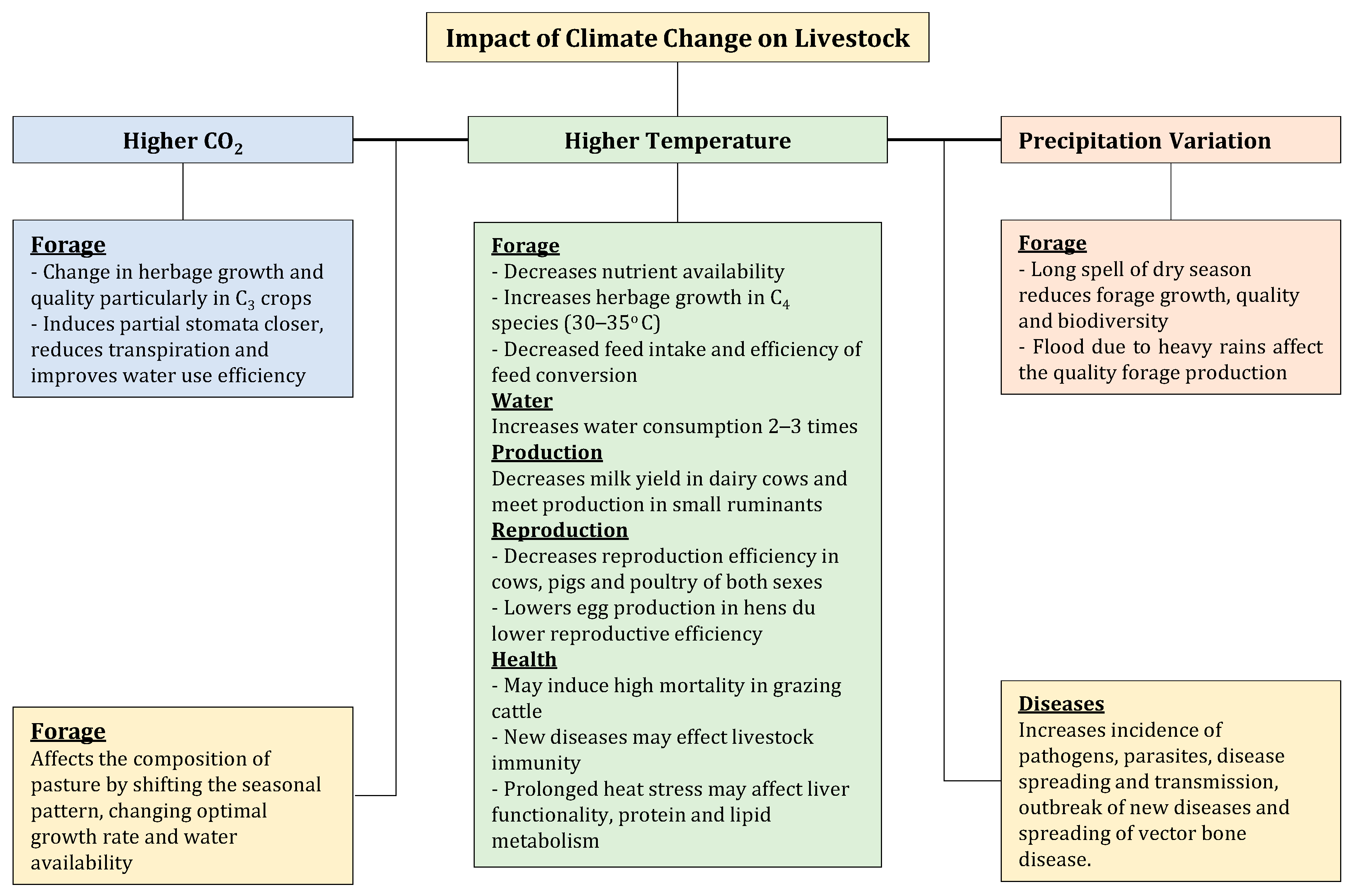
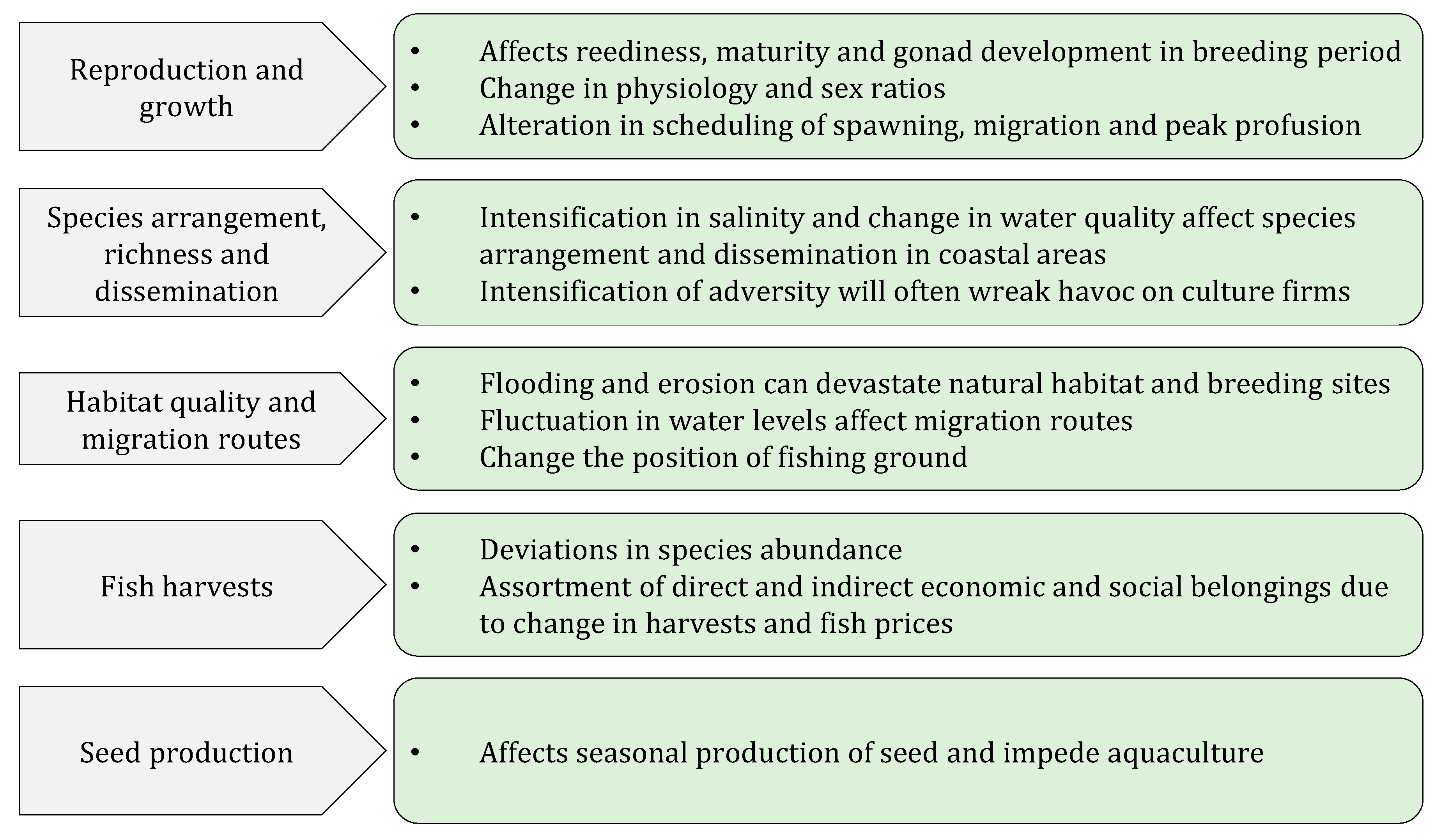
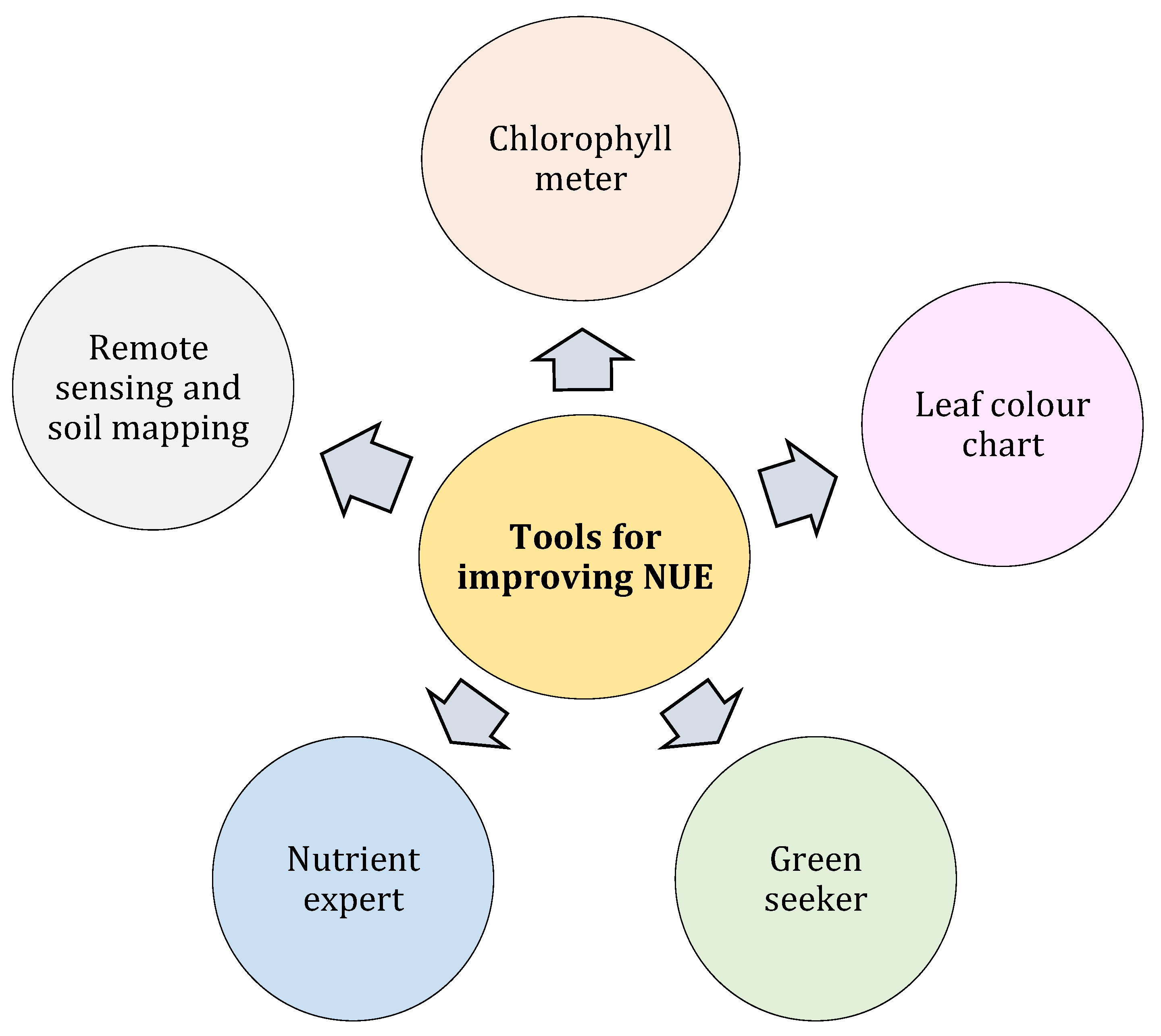
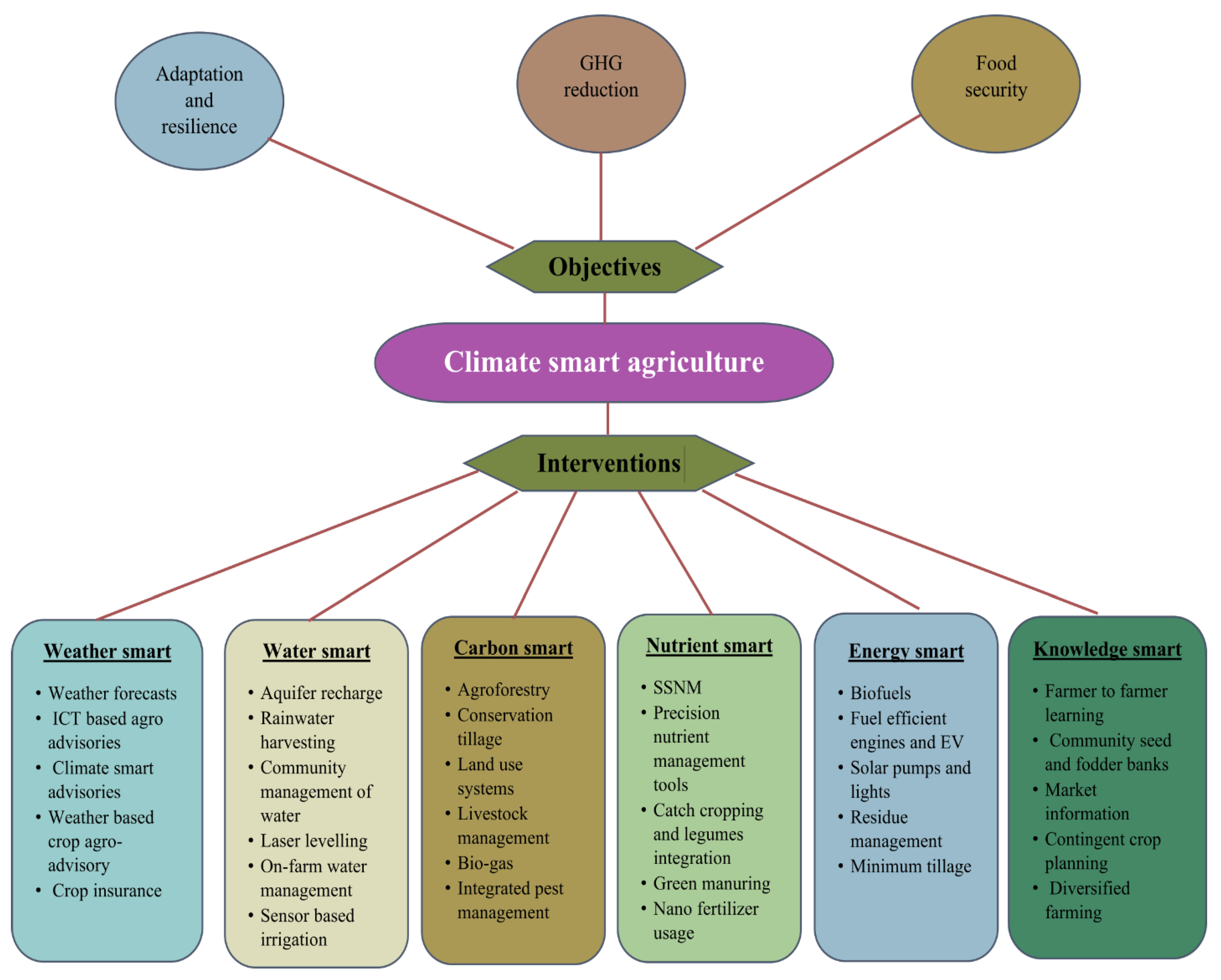
| Higher CO2 Fertilizer | Higher Temperature Levels | Precipitation Variability |
|---|---|---|
|
|
|
| Decision Tools | Utility |
|---|---|
| Manage-N | Site-specific nitrogen management tool |
| Amaize-N | Yield forecasting and nitrogen management tool for maize |
| NuDSS | SSNM tool for rice |
| Nutrient Expert | SSNM tool for rice, maize, and wheat |
| QUEFTS | SSNM tool for rice and wheat |
| Adapt-N | Nitrogen manager in maize |
| Expert-N | Site-specific nitrogen management tool for wheat and annual crops |
| Rice crop manager | SSNM tool for rice |
| Management tool | Crop | Output | Ref. |
|---|---|---|---|
| Nutrient expert | Rice, Wheat |
| [56] |
| Leaf color chart | Rice |
| [57] |
| Variable rate technology | Corn |
| [58] |
| Leaf color chart | Rice |
| [59] |
| LCC, SPAD, Green Seeker canopy reflectance sensor | Wheat |
| [60] |
Disclaimer/Publisher’s Note: The statements, opinions and data contained in all publications are solely those of the individual author(s) and contributor(s) and not of MDPI and/or the editor(s). MDPI and/or the editor(s) disclaim responsibility for any injury to people or property resulting from any ideas, methods, instructions or products referred to in the content. |
© 2023 by the authors. Licensee MDPI, Basel, Switzerland. This article is an open access article distributed under the terms and conditions of the Creative Commons Attribution (CC BY) license (https://creativecommons.org/licenses/by/4.0/).
Share and Cite
Balasundram, S.K.; Shamshiri, R.R.; Sridhara, S.; Rizan, N. The Role of Digital Agriculture in Mitigating Climate Change and Ensuring Food Security: An Overview. Sustainability 2023, 15, 5325. https://doi.org/10.3390/su15065325
Balasundram SK, Shamshiri RR, Sridhara S, Rizan N. The Role of Digital Agriculture in Mitigating Climate Change and Ensuring Food Security: An Overview. Sustainability. 2023; 15(6):5325. https://doi.org/10.3390/su15065325
Chicago/Turabian StyleBalasundram, Siva K., Redmond R. Shamshiri, Shankarappa Sridhara, and Nastaran Rizan. 2023. "The Role of Digital Agriculture in Mitigating Climate Change and Ensuring Food Security: An Overview" Sustainability 15, no. 6: 5325. https://doi.org/10.3390/su15065325
APA StyleBalasundram, S. K., Shamshiri, R. R., Sridhara, S., & Rizan, N. (2023). The Role of Digital Agriculture in Mitigating Climate Change and Ensuring Food Security: An Overview. Sustainability, 15(6), 5325. https://doi.org/10.3390/su15065325









